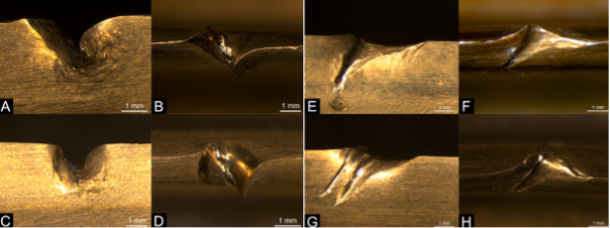
Bronze Age Spear Fights Recreated Through Simulating Ancient Combat Techniques
A new study has confirmed what we already suspected and knew, but in much more elaborate detail: the Bronze Age was a long, long bloodbath. The team of researchers, including experts from Göttingen University, have recreated ancient combat techniques by simulating Bronze Age spear fights. They carefully recreated battles, blow by blow, to understand how these weapons were used and how the marks they bear came to be.
Their work has been published in the latest edition of the Journal of Archaeological Science, as the second part of a series. The first, published last month, had assessed Bronze Age swords in Bohemia and Moravia, and conducted similar simulations, offering fresh perspectives on ancient warfare and the evolution of weaponry.
- Advances in Medieval Knight Armor Could Not Match Weapon Technology!
- Greek Marines Prove Mycenaean Suit of Armor Was Fit for Battle

Experiment with experienced fighters who spar freely using different styles. two-handed spear strikes. with binding. (Valerio Gentile/Journal of Archaeological Science)
Bronze Age Spears: Tactics and Strategies of Ancient Warring
Bronze Age spears have long fascinated archaeologists, as they offer clues to the battle strategies and tactics of early civilizations. However, until now, there’d been no systematic attempt to study how these weapons interacted with each other, shields, or even the human body.
To bridge this gap, the team, consisting of licensed Martial Arts experts, created replicas of Bronze Age spears and put them to the test in real-life combat scenarios. They engaged in actual spear combat, wielding replicas of Bronze Age weapons based on artifacts found in the Netherlands. For a gruesome twist, they replaced the traditional pig carcass with the body of a roe deer to gauge the lethal effectiveness of these ancient weapons.
They didn’t stop at metal clashing against metal, but also mimicked the human body using animal tissue, allowing them to see how a spearhead would react in battle conditions. Then detailed analysis of the wear and tear on these weapons, looking at both how the marks were formed, and examining these changes over time, was conducted. Through this, they created a detailed blueprint for tracking the evolution of these marks, something that had never been done before.
- Ancient Chinese Paper Armor Put to the Test – You Won’t Believe How Strong It Is!
- Knights and Armored Steeds: Was Horse Armor Effective in Battle?

The wear and tear of bronze spearheads during the free spear fighting experiment: (A) bent tip; (B–C) socket rim damage; (D) round depression. (Valerio Gentile/Journal of Archaeological Science)
Dr. Valerio Gentile, who led the study as part of his Ph.D. research at the University of Leiden and now continues similar work at the University of Göttingen, believes this research will have lasting benefits.
"We've created a detailed guide for recognizing and interpreting the wear on Bronze Age weapons. This guide will allow researchers and curators to revisit the artifacts in their collections with new eyes. By comparing the marks they find with our documented examples, they’ll be able to unlock new stories about these ancient tools of war,” she explained in a press release.

Some of the wear and tear from battle that occurred during the experiment with controlled impacts on the replica bronze spearheads: (A–B) Notch with burr, side and top view. (C–D) Notch with burr, side and top view. (E–F) Bowing dent with trail, side and top view. (G–H) Bowing dent with trails, side and top view. (Valerio Gentile/Journal of Archaeological Science)
What They Learnt: Combat Was More Brutal Than Thought
The results were eye-opening: Not only did the team discover clues about the skills and techniques needed to effectively wield a Bronze Age spear, but they also found that the marks they replicated on their spearheads matched those found on many archaeological examples. This means that, for the first time, it’s possible to tell whether a spear in a museum collection was actually used in combat — and if so, how it was used!
In fact, the weapons shattered the deer’s leg bones, a finding that challenges previous archaeological assumptions, reports IFL Science. Many injuries in the ancient record that were once thought to be the result of blunt force trauma may have actually been caused by spears. "The wounding experiments showed the offensive potential of these weapons," wrote the study authors, confirming that they were highly effective in lethal, life-or-death combat situations.
One of the most exciting implications of the study is its potential to reveal whether these spears were primarily used in one-on-one duels or large-scale battles. Understanding this could shed light on the nature and intensity of conflicts in the Bronze Age — and by extension, on how early societies functioned and interacted – a work of future studies.
In essence, this research has transformed how we can study ancient warfare. The team’s method provides a repeatable, scientific way to investigate the past, opening up exciting new possibilities for uncovering the secrets of Bronze Age combat. Perhaps most tellingly, the wear patterns on these replica spears mirrored the damage found on authentic Bronze Age blades, suggesting use in a variety of combat scenarios, leading to a wide range of injuries.
“Our findings show how weapons were used and what techniques were employed. We may also be able to use our research to find out whether the Bronze Age weapons were used in large-scale battles or in duels. This is important for understanding the nature and intensity of conflicts in the past,” concluded Dr. Valerio.
Top image: Left; Right; Experiment, one-handed spear and shield fight. Source: Valerio Gentile/Journal of Archaeological Science)
By Sahir Pandey
References
Gentile, V. et al. 2024. Multi-stage experiments in Bronze Age spear combat: insights on wear formation, trauma, and combat contexts. Journal of Archaeological Science, 170. Available at: https://doi.org/10.1016/j.jas.2024.106044.
Taub, B. 2024. Bronze Age Weapons Were Mega Lethal – Scientists Made Their Own To Prove It. Available at: https://www.iflscience.com/bronze-age-weapons-were-mega-lethal-scientists-made-their-own-to-prove-it-75765.














